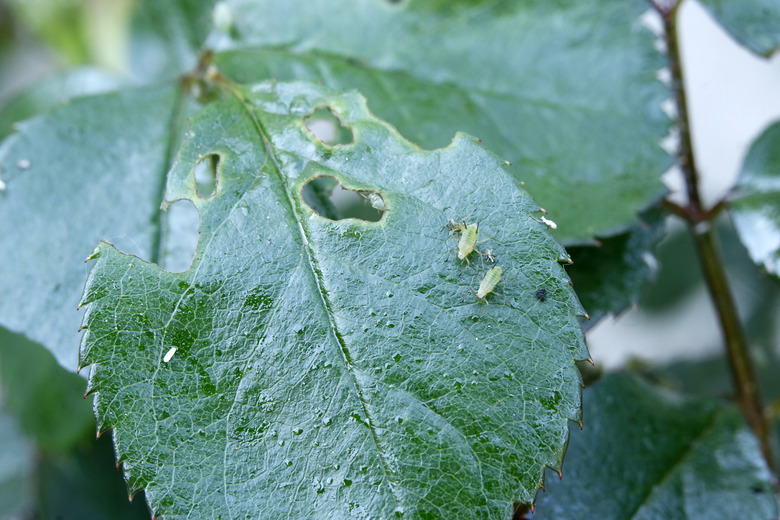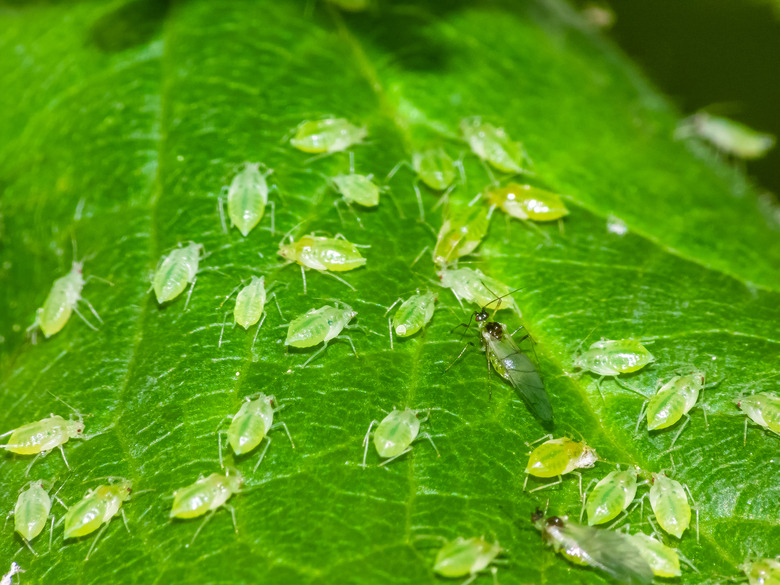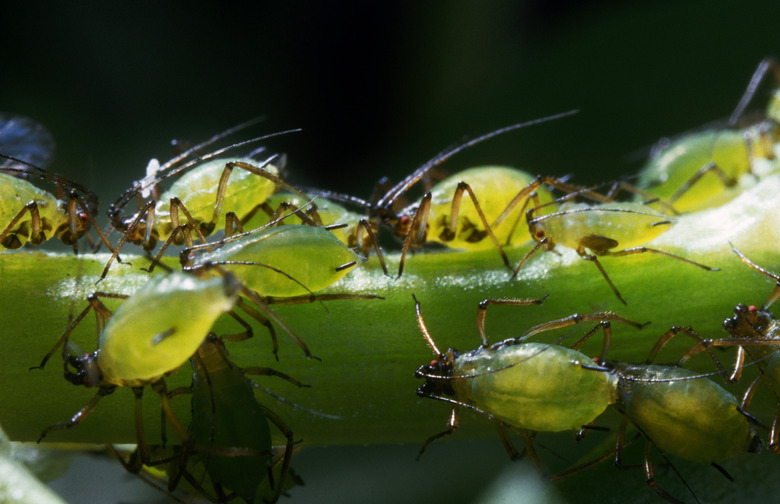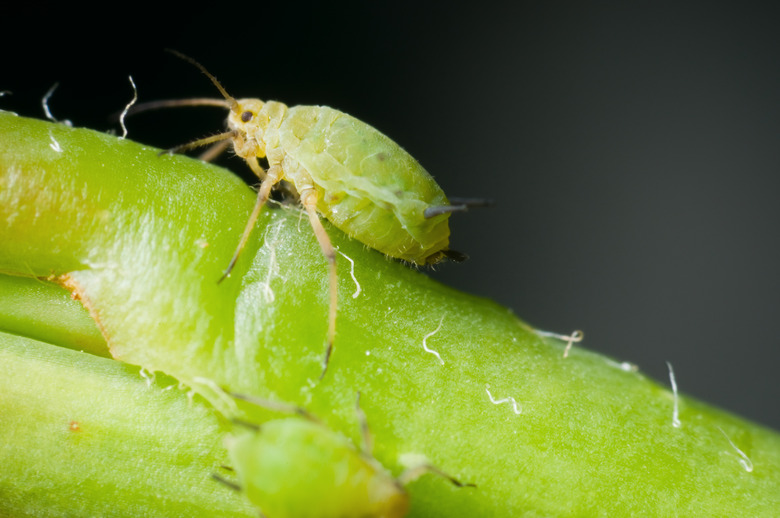How To Get Rid Of Aphids
We may receive a commission on purchases made from links.
An aphid infestation is a gardener's most notorious enemy. Though small, aphids can create big damage, feasting on your trees and shrubs, and the damage can be unsightly. There are plenty of aphid species, and they all consider your green leaves as their food source. All aphids manufacture honeydew, a sticky substance that promotes the growth of sooty mold and attracts ants. On top of shriveled leaves and misshapen blooms, there's nothing like an ant trail to complement your rose garden.
Aphids damage plants by piercing stems, leaves, and buds with their mandibles and sucking out the nutrient-rich juices. Aphids are small, so a single insect wouldn't do much damage, but aphids never dine alone, and when you see one, you can be sure there are thousands of others around. Aphids are normally found on the underside of leaves, and the leaves on which they congregate respond to the loss of sap by turning yellow and wilting. They may also turn black as sooty mold — which thrives in the honeydew aphids produce as a waste product — becomes established. Aphids can stunt plant growth as well as cause misshapen blooms.
Fortunately, all but the most sensitive plants easily recover from an aphid infestation, and both honeydew and sooty mold wash off with water, so the most common way to get rid of aphids is to spray them off with a garden hose. You can also pick off the tiny critters with your fingers or spray them with neem oil or insecticidal soap. Ongoing control methods include introducing natural predators, such as ladybugs, or introducing companion plants that attract beneficial insects and/or repel aphids.
What Do Aphids Look Like?
What Do Aphids Look Like?
- Species name: There are over 4,000 species of aphids. Most belong to family Aphididae, but a few belong to other families, including Agelgidae (conifer aphids) and Phylloxeridae (gall aphids).
- Physical characteristics: Aphids are tiny — from 1/16 to 1/8 inch in length — and have soft, waxy, pear-shaped bodies. They have six legs and a pair of tubelike projections, called cornicles, extending from the rear of the abdomen. They vary in color (depending on species) and can be white, brown, black, gray, yellow, light green, or pink.
- Wings or wingless? Aphids can be both winged and wingless. Wingless adults can develop wings and fly away in search of a new nesting area when the colony becomes overcrowded. Winged aphids are closely related to whiteflies; both prefer the underside of leaves, and both produce honeydew.
- Color/species varieties: The species most likely to affect North American crops are often named for the crops they preferentially infest. Common species include the asparagus aphid (Brachycorynella asparagi), which is bluish-gray; the cabbage aphid (Brevicoryne brassicae), which is gray-green; the melon aphid (Aphis gosipii), which is pale yellow or brown; and the potato aphid (Macrosiphum euphorbiae), which is pink or green. Rose aphids (Macrosiphum rosae) are related to potato aphids and look the same, while wooly aphids (Eriosoma lanigerum), which are usually found on tree trunks and roots, are blue to purple and have a hairy coating that protects them from predators.
- Life cycle and appearance: Aphids have a complicated life cycle. Wingless females, called stem mothers, give birth to live young (without fertilization) in midsummer, and as the young mature and the colony gets crowded, some of them grow wings and migrate to other feeding grounds. Aphids also reproduce sexually. Males and females mate in the late summer, and the females lay eggs that can survive harsh winters to hatch in the spring. In areas with mild winters, the eggs may hatch throughout the winter.
- How to tell apart from lookalikes: Aphids are often confused with spider mites because the damage they cause to plants is similar. Spider mites are much smaller, however, reaching a length of only 1/50 of an inch, and because they are arachnids, they have eight legs, not six. Similarly, flying aphids are often confused with whiteflies, but the latter are mostly an indoor problem since they can't survive outdoors in the winter. Unlike oval-shaped aphids, whiteflies have elongated bodies that are almost pure white.
How to Get Rid of Aphids
How to Get Rid of Aphids
Because aphids like to hide on the underside of leaves, you don't often see them, but you can tell they are there because leaves are obviously suffering, flower buds and fruits are underdeveloped, and the discoloration of sooty mold is often evident. You'll often see an ant trail leading to an aphid colony because ants are attracted to the honeydew, and they often corral the aphids to protect them to encourage them to produce more of the sticky-sweet substance. The ants are not the problem you need to address, though — the aphids are. Fortunately, getting rid of an aphid infestation isn't all that difficult.
Pick Off Aphids With Your Fingers
If you see a few aphids on your houseplants or in the garden, the easiest way to get rid of them without disturbing the plants is to pick them off with your fingers. This won't work if you have a full-on infestation, but if you see just a few, killing them in this way can prevent an infestation from occurring.
Spray the Plants With Water
You can usually knock garden pests, like aphids, off leaves and stems with a good blast from a garden hose, which will also wash off honeydew deposits and any sooty mold that has developed. Once dislodged, the aphids usually can't find their way back to the same leaf, but they may congregate elsewhere, so you have to watch for them and spray them again if they reappear.
Spray With Soapy Water
Control aphids by filling a spray bottle with a mixture of water and dish soap or liquid soap, such as Castile soap. This treatment works best if you precede it by spraying the plants with plain water first to knock off as many of the insects as possible. Soapy water desiccates the soft, waxy aphid bodies, and you can make the solution more effective by adding a little cayenne, which will finish the job of killing them. Adding isopropyl alcohol to the mixture will also boost its effectiveness.
Soapy water only kills the insects with which it comes in direct contact, so a thorough drenching is required. Be sure to test this spray on one part of the plant before broadcasting it widely. Treat indoor plants that you can't spray by wiping down aphid-infested leaves with soapy water.
Spray With Insecticidal Soap or Essential Oil
Insecticidal soap kills on contact without causing harm to the plant. If you have an aphid problem indoors where spraying isn't possible, wipe the soap onto the leaves with a damp cloth. Neem oil and other essential oils, such as peppermint, clove, rosemary, and thyme, can also be effective when used by themselves or when mixed together in a solution.
Dust the Plants With Diatomaceous Earth
Diatomaceous earth (DE) can kill aphids and most other soft-bodied insects by creating multiple lacerations on their soft exoskeletons. Food-grade diatomaceous earth is generally safe to use, although you should wear a respirator to avoid breathing in the dust. Do not use DE when plants are in bloom because it can harm pollinators, like bees and hoverflies. If you're looking for a safer dusting powder than DE, try using flour. It doesn't cause any lacerations, but it constipates adult aphids.
Reduce Aphid Populations With Predators
Ladybugs, sometimes known as lady beetles, are some of the most beneficial bugs you can release in your garden. Other effective aphid predators include brown and green lacewings, damsel bugs, dragonflies, and soldier beetles. Parasitic wasps lay eggs on aphids, and when the larvae appear, they consume the insects from within.
How Quickly Can You Get Rid of Aphids?
How Quickly Can You Get Rid of Aphids?
The main obstacle to speedy control of an aphid infestation is the sheer number of aphids involved. Whether you spray the leaves with soapy water or wipe them down with essential oil, some of the aphids will survive and create a new problem elsewhere in the garden or greenhouse. To prevent this, spray or wipe every two to three days for about two weeks or until all evidence of activity disappears.
Where Aphids Come From
Where Aphids Come From
Because aphids are tiny and can fly, they can appear almost anywhere. When they appear indoors, they are sometimes referred to as plant lice. They can enter through an open window or can cling to clothing or plants transferred indoors for the winter. Given that females can give birth to live young without fertilization and that each female can produce three to six offspring every day for several weeks, an indoor aphid infestation can grow quickly.
Adult aphids aren't active outdoors in the winter in cold climates, but the eggs survive the winter and hatch in the spring, and infestations of adults can occur from midspring until fall. Indoors, aphids can survive and reproduce all year and may be especially troublesome during the winter.
How to Prevent an Aphid Infestation
How to Prevent an Aphid Infestation
Companion planting is one of the most effective ways to prevent an aphid infestation. Some plants, such as clover, mint, dill, fennel, and yarrow, attract beneficial bugs that help control aphid populations. Aphids feed on other plants, such as nasturtium, zinnias, cosmos, dahlias, and mustard, and these plants can be used to lure aphids and allow you to spray them. Check these "trap" plants regularly and spray them with soapy water to kill the aphids that have congregated. Aphids will stay away from catnip, chives, garlic, and onion, and any one of these plants can be used in companion planting as an aphid repellant.
To prevent an indoor infestation, isolate outdoor plants for at least two weeks and then inspect them thoroughly before bringing them indoors. Inspect all your indoor plants every two to three weeks and deal with any aphids you see promptly, either by picking them off the plants or wiping the leaves with soapy water.
Signs of Aphid Damage
Signs of Aphid Damage
Aphids aren't known to be significant vectors of disease, and although they can spread plant viruses, such as cucumber mosaic virus, they pose little danger to humans or pets. Many aphid species are selective in the types of plants they prefer and can spread diseases among crops. Most of the damage from aphids is caused by their feeding habits, which can stunt plant growth and render leaves and stems discolored and shriveled. The honeydew that aphids produce also promotes sooty mold, although as far as molds go, this is a fairly benign one that you can wash away.
Because ants are attracted to honeydew, one of the primary indications of an aphid infestation is a trail of ants leading to a particular plant. You'll often notice wilted leaves at the end of the trail, and if you look under the leaves, you'll see the aphids at work. These garden pests are attracted to new growth, so you often find them teeming around budding leaves on branches and immature flower buds. If left untreated, these buds may display defects as they bloom.
References
- The Old Farmer's Almanac: Aphids
- Britannica.com: Aphid
- University of Minnesota Extension: Aphids in Home Yards and Gardens
- Garden Design: How to Get Rid of Aphids Naturally
- Better Homes & Gardens: How to Get Rid of Aphids in Your Garden Before They Damage Your Plants
- Missouri Botanical Garden: Aphids – Indoors
- University of Kentucky: Aphids



